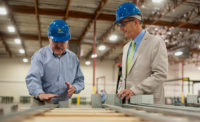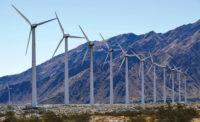Tell Us What Rapid Energy Changes Mean to You

First Solar Desert Sunlight Solar Farm.
Photo Courtesy Dept. of Interior
When I first started writing about energy, U.S. onshore oil and gas production was barely a blip on the world market. New multi-billion nuclear plants seemed like a logical, long-term choice to meet an increasing demand for electricity. Natural gas was the stepchild of power generation because of the fuel’s price swings. And solar and wind power still seemed like a pipedream. Microgrids and battery storage? Aside from the occasional demonstration project, they were just a step above science fiction.
That was eons ago…. in 2006.
Since then, energy and the electric grid have changed at a rapid and historic pace, upending long-held notions of energy production and electricity generation.
Today, the U.S. is expected to become a net exporter of oil and gas by 2022—four years earlier even than the Energy Dept. forecast just last year. After years of steady growth in electricity demand, more efficient homes and appliances have led to flattened demand for electricity, meaning there’s little need to build new power plants. Because natural gas is so cheap, and looks to remain so for the future, natural gas combined cycle and simple cycle plants – not coal or nuclear—are often best option for baseload plants to fill what need there is.
But even cheap natural gas may soon be bypassed by renewable generation. A recent solicitation from Colorado’s Xcel energy to replace about 450MW of coal resulted in bids from solar and wind developers so low that choosing any other generation technology would be insane. Wind-only bids had a median price quoted of $18/MWh, meaning half of the bids were below that. Solar only came in at a median price of $29.50/MWh.
In November, consultant firm Lazard found in its annual analysis that in some scenarios, the life-cycle costs of renewables projects have dropped below the operating costs alone of conventional generation technologies such as coal or nuclear. Costs are only going to continue to decline. In just one year, the levelized cost of utility-scale solar photovoltaic (PV) and onshore wind technologies fell 6%.
The possibility of affordable, reliable battery storage is another paradigm shift. According to Black & Veatch’s 2017 Annual Strategic Directions survey, the majority of utilities responding to its survey are beginning to eye renewables paired with battery storage as a way to “harness distributed supply and improve system flexibility and resilience.” The Federal Energy Regulatory Commission’s recent order opening up wholesale electricity markets to storage will further that end.
Over the next five years, 44 % of the electric utilities in Black Veatch’s survey plan to invest in solar, 43% in wind and 34% in natural gas. Fewer than 2% plan to add new coal-fired generation. So much for bringing back coal. In fact, a recent analysis found that more coal capacity closed in the first 45 days of 2018 than in the first three years of the Obama administration.
But as Lazard notes, “alternative energy systems alone will not be capable of meeting the baseload generation needs of a developed economy for the foreseeable future. Therefore, the optimal solution for many regions of the world is to use complementary conventional and alternative energy resources in a diversified generation fleet.”
“The transition away from coal and nuclear will see natural gas-fired combined cycle plants playing an outsized role, and in many ways they will be the bridge between legacy generation sources and increasing reliance on distributed generation, renewables, microgrids and energy storage,” says Alap Shah, vice president and director of technologies and services area for Black and Veatch's power business. “Bringing these diverse sources of electricity to customers will require significant investments related to transmission. Demand from both residential customers and large manufacturers for lower emissions energy sources is positioning gas alongside these emerging sources to lead power generation going forward, and we expect to remain busy helping utilities meet that generation demand and associated transmission network build-up and upgrade.”
Here are a few of my own takeaways on what these rapid changes will mean:
- Innovation is important but won’t drive the industry.
- Distributed generation and renewables are important, but they won’t yet change the fundamental nature of the grid.
- With the U.S. stepping out of the Paris accord, look to states and cities to push utilities to secure lower carbon generation. It’s already happening in California and New York.
What else do you see in the rapidly changing energy market? Do you have any unique energy projects that we at ENR should know about? Do you have an idea that you would like to appear in this spot in coming months? Please comment here, or contact me at russellp@enr.com.



